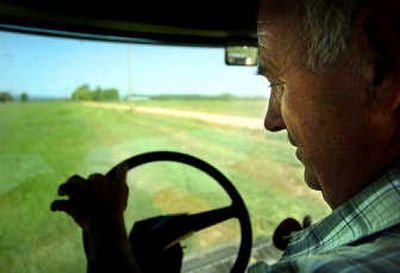Making hay

As familiar as ice cream trucks roaming city streets, hay fields dotted with stacks of bales herald midsummer in the country. The sweet scent of hay at dusk envelopes passers-by in a cloud of summertime memories.
For Paul Hudson the soft smell is a reminder of hard work. He’s farmed his acreage near Clayton since 1973. The 60-year-old farmer climbed down from his green and gold John Deere on a recent afternoon to take a well-earned break and talk about hay.
“It’s a good time to be a hay farmer,” he said.
A few cows moseyed up to the fence to check out their visitor, while a “mostly tame” barn cat peeked warily from behind a bush. A ramshackle white building next to the barn sported a wooden sign “P&C Massage Parlor.”
No, Hudson hasn’t opened up a new business. The sign adorns the former milk house. “We used to have milk cows, but we quit that 20 years ago,” he said. The sign was created at the suggestion of a neighbor and refers to the act of massaging the cow’s teats while milking. “We kinda like it,” Hudson said with a grin.
Inside the dark, cool house, Charlotte Hudson, Paul’s wife of 35 years, reflected on their life together. “We met at WSU,” she said. “It was his lucky day.” They married, and Paul taught school for a year, but the love of the land was in his blood. “I was raised on the farm,” he said. “It’s all I know.” So, they bought his parents’ farm and settled down to make it their own.
Much has changed in 34 years. Local author Ruth McHaney Danner said, “Some of my earliest fond memories are riding on the hay wagon, high atop the stacked bales. Then I graduated to driving the tractor, which was fun, too. Then I got big enough to pitch the loose hay, and the sport was no longer fun.”
Indeed, farm work used to be many folks’ first foray into earned income.
North Side resident Mary Roy said, “I rolled bales of hay. They used to have to be put on their correct side so the hay stacker could go through the rows quickly and pick them up. I could pop the muscles in my back and scare off any boy with a single glance. We’re talking buff! Each bale was over 50 pounds.”
Now, Hudson says the tasks the two women mentioned are mechanized. “That’s been the biggest change over the years. I used to have as many as six kids hauling hay,” he said. “And Charlotte would feed them a big lunch. By 1984 we were all mechanized.”
He doesn’t really miss the old days, though he enjoyed having the kids around. The couple’s only child, a daughter, lives in Spokane with her family. The farm is now a one-man operation, and he likes it that way.
A swather cuts the hay and puts it into windrows, then Hudson attaches his rake to the tractor and rakes the crop so it will dry quicker. After the hay has dried a couple of days, a baling machine forms the hay into tidy square bales which weigh about 80 lbs. each.
Some farmers have their hay rolled into large round bales weighing 600 to 1,000 lbs. Hudson said the rolled bales shed water better, which is a good thing.
“If it rains, my little bales mold and rot away to nothing.” However, he shuns the huge bales because he sells his hay primarily to local cattle farmers and horse owners. “Sooner or later someone is going to pick my bales up,” he said.
The term “a roll in the hay,” loses some of its romance when you realize hay is nothing more than cattle food. “It’s good for llamas too,” said Hudson with a laugh.
The large round bales often are shipped overseas. According to Hudson, 25 percent to 30 percent of hay grown in Eastern Washington is exported to Japan and South Korea.
“The big story is the price of hay,” he continued. “It’s going through the roof because we all have less hay. This about the driest year we’ve had since 1973. We always have a third cutting, but no rain means we’ll only have two cuttings this year.”
Like many hay growers in Eastern Washington, the Hudsons are dryland farmers. “We depend on natural irrigation,” he said. “We don’t use sprinklers.”
This is his busiest time of year. From early in the morning until late at night Hudson is working his 350 acres of cropland in addition to managing 150 acres of pasture with cattle.
He enjoys the freedom of his life. No one tells him when to get up or what to.
“Hay farmers are about as independent as a farmer can get,” he said. Unlike other crops there is no governmental regulation on the price of hay. “We set our own price. I like that.”
This year’s crop is already sold out.
“I’m probably going to have 800 tons this year. I usually have 1,100,” he said.
When asked about retirement Hudson said, “I don’t plan on retiring. Once the real haying is over, I’ve got a pretty nice life.” Though his tanned face, creased eyes and calloused hands speak volumes about strenuous labor, he shrugged and smiled at his wife. “I don’t have to work that hard.”